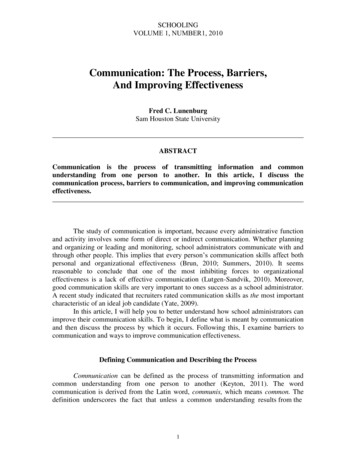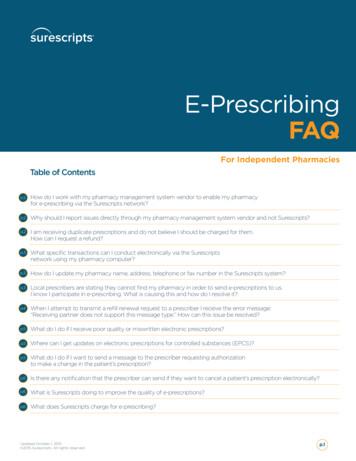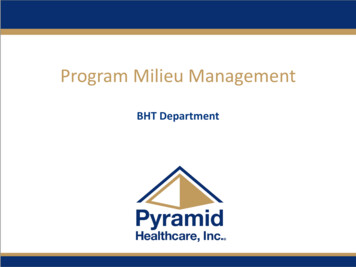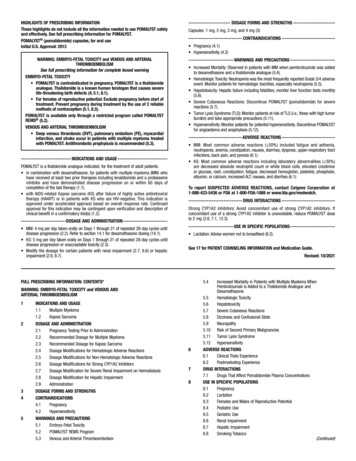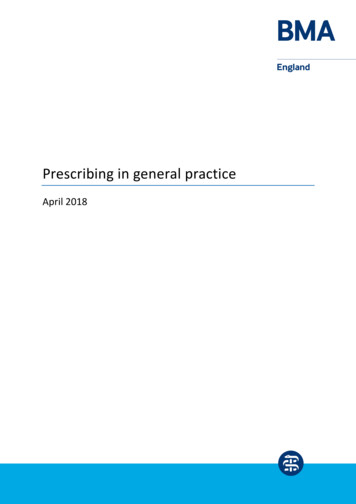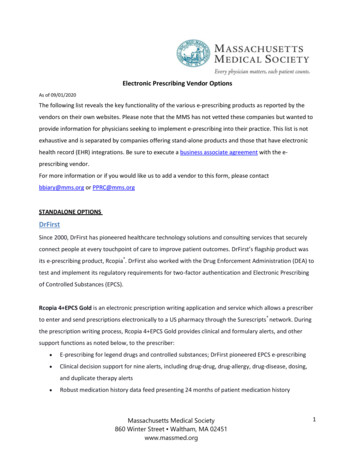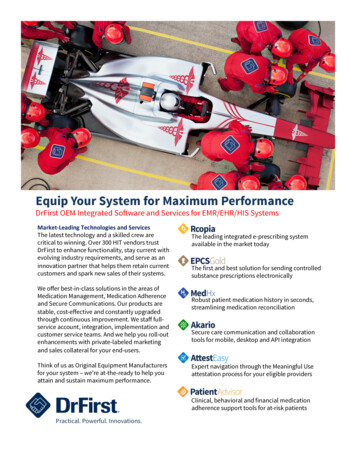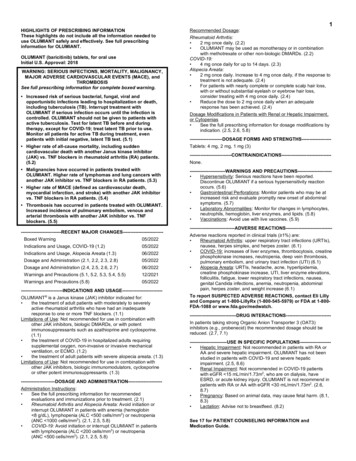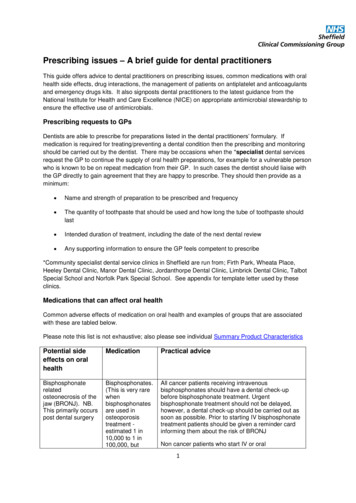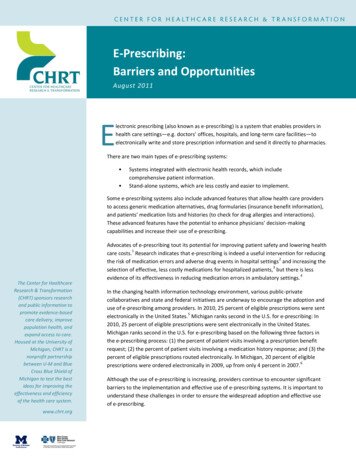
Transcription
E-Prescribing:Barriers and OpportunitiesAugust 2011Electronic prescribing (also known as e-prescribing) is a system that enables providers inhealth care settings—e.g. doctors’ offices, hospitals, and long-term care facilities—toelectronically write and store prescription information and send it directly to pharmacies.There are two main types of e-prescribing systems: Systems integrated with electronic health records, which includecomprehensive patient information.Stand-alone systems, which are less costly and easier to implement.Some e-prescribing systems also include advanced features that allow health care providersto access generic medication alternatives, drug formularies (insurance benefit information),and patients’ medication lists and histories (to check for drug allergies and interactions).These advanced features have the potential to enhance physicians’ decision-makingcapabilities and increase their use of e-prescribing.The Center for HealthcareResearch & Transformation(CHRT) sponsors researchand public information topromote evidence-basedcare delivery, improvepopulation health, andexpand access to care.Housed at the University ofMichigan, CHRT is anonprofit partnershipbetween U-M and BlueCross Blue Shield ofMichigan to test the bestideas for improving theeffectiveness and efficiencyof the health care system.www.chrt.orgAdvocates of e-prescribing tout its potential for improving patient safety and lowering health1care costs. Research indicates that e-prescribing is indeed a useful intervention for reducing2the risk of medication errors and adverse drug events in hospital settings and increasing the3selection of effective, less costly medications for hospitalized patients, but there is less4evidence of its effectiveness in reducing medication errors in ambulatory settings.In the changing health information technology environment, various public-privatecollaboratives and state and federal initiatives are underway to encourage the adoption anduse of e-prescribing among providers. In 2010, 25 percent of eligible prescriptions were sent5electronically in the United States. Michigan ranks second in the U.S. for e-prescribing: In2010, 25 percent of eligible prescriptions were sent electronically in the United States.Michigan ranks second in the U.S. for e-prescribing based on the following three factors inthe e-prescribing process: (1) the percent of patient visits involving a prescription benefitrequest; (2) the percent of patient visits involving a medication history response; and (3) thepercent of eligible prescriptions routed electronically. In Michigan, 20 percent of eligible6prescriptions were ordered electronically in 2009, up from only 4 percent in 2007.Although the use of e-prescribing is increasing, providers continue to encounter significantbarriers to the implementation and effective use of e-prescribing systems. It is important tounderstand these challenges in order to ensure the widespread adoption and effective useof e-prescribing.
Barriers to Widespread Adoption of E-PrescribingIn the last several years, e-prescribing has been the focus of both statewide legislation and regional public/privatecollaboratives. More recently, federal initiatives have been designed to incentivize providers to adopt e-prescribing systems.In 2008, Medicare began providing bonus payments to physicians who e-prescribed medications. Between 2008 and 2009,78the electronic routing of prescriptions through Surescripts more than doubled nationally from 12.1 percent to 25 percent.Although e-prescribing is increasing in the United States, the vast majority of prescriptions are still not sent electronically. Theuse of e-prescribing among providers still lags behind policy goals, suggesting that policy and financial incentives alone arenot enough to accelerate widespread adoption of e-prescribing.A recent qualitative study by the Center for Studying Health System Change found that only 40 percent of physicians in office9based ambulatory settings had access to e-prescribing in 2008. Beyond lack of access to the technology, research shows thatthe lack of e-prescribing uptake in outpatient settings results from a number of key factors. Technological complexity,incomplete patient data, and physician attitudes toward e-prescribing all greatly affect the implementation and successfuluse of e-prescribing.Complex Technology and Data AvailabilityMany e-prescribing systems have advanced features that provide electronic access to important patient information, such aspatient medication histories, formulary information, and generic alternatives. These features enhance the basic ability towrite and store prescriptions electronically, but are not available in all e-prescribing systems. For example, in 2009 only 62percent of the physicians who routed prescriptions electronically via Surescripts had access to medication histories, and just60 percent had access to patient formularies. Even when physicians had access to these features, they did not always usethem: 56 percent used the interface with patient medication histories most or all of the time and 34 percent used theinterface with drug formularies most or all of the time.E-prescribing system design varies by software vendor, and the technology is often complex and time consuming to use.Some systems display medication history prominently on the screen at the start of the prescribing session, and others requirethe prescriber to go through several steps to bring up that information. Not surprisingly, physicians are more likely to use themedication history feature in systems where it is readily available.The same is true for formulary information, which allows the physician to view a list of medications covered by the patient’shealth plan. Prescribers are much more likely to use e-prescribing systems to review a patient’s formulary details if thefeature is automated and integrated into the workflow. Better systems let the prescriber know if an entered medication is onformulary, and if not, suggests alternative medications. More cumbersome systems do not offer these alternatives andrequire the prescriber to manually check each medication by trial and error.The successful use of these features also depends on the availability and accuracy of patient information. Not all insurersshare patient data with vendors for use in e-prescribing features, inhibiting consistent access for all patient medicationhistories and formularies. Physicians are much less likely to use these features if the data are not consistently available for allinsured patients. And even when patient information is available, information can be out-of-date or incomplete. For example,10medication history data is either entered manually by clinical staff or pulled from each participating health plans’ claimssystem reports. Medications which are paid for completely out-of-pocket are not included in the patient’s history, and in the11era of retail pharmacies and four dollar generic drugs, incomplete medication histories are common.E-Prescribing: Barriers and Opportunities Center for Healthcare Research & Transformation, August 20112
Physician Attitudes12,13,14Another factor that can become a barrier to successful implementation and use of e-prescribing systems is providerexpectations. For example, some physicians expect the technology to increase the speed of clinical care, and give up on usingthe system when they encounter difficulties and lack technical support.Studies suggest that primary care physicians and practices that are more familiar with health information technology aremore successful in fully implementing e-prescribing systems and managing expectations of the benefits. In fact, research alsosuggests ambulatory care practices that have successfully and fully implemented e-prescribing share common traits:Physicians have positive attitudes and are committed to learning more about e-prescribing and other healthinformation technology.Physicians and support staff have realistic expectations about the overall benefits of e-prescribing and expect sometechnical difficulties and disruption of office workflow during implementation.Like successful practices, those that have been unsuccessful in implementation share commonalities. In addition to a lack offamiliarity with e-prescribing or other health information technology, these following contribute to their lack of e-prescribinguse:Physicians often have high expectations about the ease of implementation, yet are concerned with how eprescribing may affect their clinical independence and authority.Physician focus is primarily on the use of e-prescribing to increase the speed of prescribing.Staff has very little advance knowledge of the potential effect on prescription workflow or understanding that theexisting work processes may need to change in order to accommodate new technology.In response to problems with the program during implementation, physicians perceive that the e-prescribingcompany is not very responsive to their concerns.Other commonly identified barriers include increased costs, insufficient time for clinicians and staff to learn the new systems,and the additional effort needed to adapt office systems and manage technical difficulties. All of these factors would need tobe addressed to realize the potential benefits of e-prescribing.ConclusionWhile many advocates of e-prescribing promote its use in improving health care safety, quality and efficiency, there aresizable gaps between the use of e-prescribing and policymakers’ vision for its widespread adoption. Governors, stateagencies, and legislators have used various approaches to advance the adoption of e-prescribing by creating incentives,addressing policy barriers to implementation, and using regulatory authority to support e-prescribing goals. Given therelatively recent availability of federal funding established to encourage the use of e-prescribing, the number and diversity ofthese actions and initiatives continue to proliferate. (See Appendix for more information.) As states and the federalgovernment work to advance e-prescribing use, it is important to understand what factors support or hinder its adoption anduse among physicians.Given the barriers to implementation and use, policymakers should consider multiple strategies to encourage widespreadadoption. Beyond the financial support that many current e-prescribing initiatives provide, initiatives should address theavailability of advanced features and patient data provided through these features, the complexity of the technology, andprovider and staff understanding of implementation and use. Specifically, stakeholders and policymakers should consider thefollowing in designing e-prescribing initiatives and incentives:E-Prescribing: Barriers and Opportunities Center for Healthcare Research & Transformation, August 20113
1.2.3.Data availability is a key aspect in determining the usefulness of e-prescribing functions. Increased participation in eprescribing systems by health insurers and state Medicaid programs is important so that providers have consistentaccess to complete medication histories and formulary information for their patients while using the e-prescribingtool. Initiatives could aim at making such data readily accessible and accurate for all insured patients by encouragingall health plans to participate with vendors.It is important to choose an e-prescribing system that is relatively easy to use. Providers typically find systems withenhanced features that are automated and fully integrated into the prescribing workflow more user-friendly.Cumbersome systems can limit the usefulness of e-prescribing and lead to inefficient usage.Education and training is necessary for provider uptake and effective use and of the various components in a fully15functioning system. Providers and clinical staff should be aware of the capabilities and limitations of thistechnology and prepared to integrate it into the clinical work flow. Furthermore, practices should have timelyaccess to high quality technical support and support for managing the organizations changes that healthinformation technology implementation demands.E-Prescribing: Barriers and Opportunities Center for Healthcare Research & Transformation, August 20114
AppendixE-Prescribing in MichiganMichigan ranks second in the nation for e-prescribing. In 2009, 20 percent of eligible prescriptions were ordered16electronically, up from only 4 percent in 2007. Two initiatives have played a key role in increasing the adoption of eprescribing in Michigan:1.In 2008, Michigan enacted legislation requiring that the Michigan Department of Community Health (MDCH)develop and create a three-year strategic plan to implement e-prescribing in the Medicaid program. MDCH workedwith Surescripts, a company which provides technical support to Medicaid providers and monitors e-prescriptions,and completed a plan in July 2010. The plan focuses on increasing e-prescribing awareness among health care17providers and developing a health information system capable of tracking Medicaid e-prescribing transactions.2.The Southeastern Michigan E-Prescribing Initiative (SEMI)—a broad coalition of the big three automakers, the UnitedAuto Workers, Blue Cross and Blue Shield of Michigan, Health Alliance Plan, Henry Ford Medical Group, MedcoHealth Solutions, Inc. and CVS Caremark Corporation— launched an initiative in 2005 to increase the adoption of eprescribing. SEMI is one of the largest employer-driven initiatives for increasing e-prescribing and evaluating itsimpact. To date, SEMI has funded e-prescribing implementation for more than 3,800 physicians.Most recently, the Office of the National Coordinator for Health Information Technology awarded the Ann Arbor-basedAltarum Institute over 19.6 million in 2010 to establish the Michigan Center for Effective IT Adoption (M-CEITA) as the18state’s federally-designated regional extension center. M-CEITA is managed by Altarum and acts as Michigan’s resource forall issues related to health information technology (HIT) adoption and implementation. Beginning in 2015, the PatientProtection and Affordable Care Act of 2010 requires health care providers meet “meaningful use” standards to receive fullMedicare and Medicaid reimbursement. M-CEITA will specifically help providers prepare to implement the meaningful use19criteria for Electronic Health Records. As defined in the Health Information Technology for Economic and Clinical Health Act(HITECH) under the American Recovery and Reinvestment Act (ARRA), e-prescribing is a core objective of meaningful use andas such M-CEITA will continue to play a critical role in e-prescribing implementation.Other Statewide Actions around Electronic PrescribingE-prescribing is one of many strategies states have promoted in attempt to improve patient safety and quality of care whilereducing health care costs. In addition to participating in statewide public/private collaboratives to influence e-prescribing,direct state influence typically falls under three categories: governor-initiated actions, implementation through Medicaidagencies, and enacted legislation.Governor-Initiated ActionsGovernors have played an important role in setting the stage for the adoption of e-prescribing in their respective states.Some governors have built support by establishing statewide initiatives charged with developing and/or implementing eprescribing policy recommendations, launching communication campaigns to build awareness, and implementing regulatorychanges, such as a requirement for e-prescribing adoption.Arizona: In 2005, Arizona’s governor created the Arizona Health-e Connection, an initiative focused on promotingwidespread electronic health record adoption in the state by 2010. The Health-e Connection created a steeringcommittee in 2008 to implement e-prescribing strategies across the state by establishing and overseeing the eprescribing initiative, EAzRx. The EAzRx Steering Committee reports to the board of the Health-e Connection on theE-Prescribing: Barriers and Opportunities Center for Healthcare Research & Transformation, August 20115
progress of the mission: to achieve an e-prescribing rate of nearly 100 percent among eligible prescriptions by April2013. Following the creation of EAzRx, the governor issued an executive order that directed state agencies to workwith the Arizona Health-e Connection and EAzRx on various e-prescribing initiatives, including (1) educatingproviders and employers about the benefits of e-prescribing, (2) increasing the use of e-prescribing in the contractedhealth plans of state agencies, and (3) identifying barriers to e-prescribing adoption and making recommendationsto address them.New Hampshire: The governor issued an executive order in 2006 directing the New Hampshire Citizens HealthInitiative (a health care initiative he created in the previous year) to develop a strategic plan for health informationtechnology/exchange in the state. Delivered to the governor in January 2009, the strategic plan included acomponent to advance e- prescribing. Led by the state’s Department of Health and Human Services, the CitizensHealth Initiative has worked to implement the strategic plan and accelerate the adoption of e-prescribing among20providers. In 2009, 12 percent of eligible prescriptions in New Hampshire were routed electronically, up from213percent in the previous year.Tennessee: In December 2008, Tennessee’s governor launched e-Prescribe Tennessee, an initiative to accelerate theuse of e-prescribing as the principal prescribing method in the state. E-Prescribe Tennessee is a collaboration ofhealth care providers, pharmacies, major health plans and other health care stakeholders with the mission to:establish requirements for e-prescribing standards and best practices, incorporate e-prescribing into the dailyworkflow for providers and pharmacies, perform provider education and outreach about e-prescribingopportunities, and evaluate recommendations to remove barriers to statewide e-prescribing adoption.E-Prescribing in State Medicaid AgenciesOne of the best opportunities for states to have an impact on e-prescribing activities is by leveraging state-administeredhealth care programs—mainly Medicaid. States are increasingly expanding Medicaid’s information technology systems toaccommodate e-prescribing by linking the Medicaid Management Information Systems (MMIS) with e-prescribing networks.Florida: Since July 2003, Florida’s Medicaid program (the Agency for Health Care Administration or the Agency) hasprovided resources to assist Medicaid physicians in adopting e-prescribing. Specifically, the program supplies highvolume Medicaid physicians with free personal digital assistants (PDAs), fully equipped with software to e-prescribe,access to medication history, Medicaid drug lists, drug utilization reports, and drug pharmacology information.Established in November 2009, the Florida Medicaid Health Information Network (Medicaid HIN) provides anotheroption for providers to access e-prescribing through an online tool that provides e-prescribing and drug informationsoftware at no charge. The agency continues to monitor the use of e-prescribing among Medicaid providers, identify22the barriers to implementation, and create initiatives aimed at addressing those challenges.23New York: New York’s Medicaid program developed a program offering financial incentives to providers for eprescribing with three goals: (1) reducing medication errors, (2) increasing patient safety, and (3) reducing costs. Asof March 2010, the Medicaid program pays 0.80 to physicians and 0.20 to pharmacies for each electronicallyprescribed medication for a Medicaid enrollee, and an additional incentive for refill prescriptions. Physicians are paidthe incentive through quarterly bundled payments and the pharmacies receive payment when prescriptions arefilled as an add-on in the dispensing fee. The program is strictly for incentive purposes and does not include anypenalty for non-participating physicians or pharmacies. New York budgeted 119,504,000 for the program inFY2009-2010.To establish this program, the Office of Health Insurance Programs (which administers New York’s Medicaidprogram) spent two years researching the potential impact of e-prescribing and working with various stakeholdersto develop the program and gain legislative support. Stakeholders included representatives from Medicaid, theE-Prescribing: Barriers and Opportunities Center for Healthcare Research & Transformation, August 20116
Office of Health Information Technology Transformation, and the State Pharmacy Board. The incentive program wasdeveloped based on the workgroup’s estimate that Medicaid would save 1.82 per each electronically-prescribedmedication due to the decrease in medication errors and the cost of printing official New York paper prescriptions.The committee proposed that the cost savings be shared among Medicaid, the prescribing physician, and the24pharmacy.Tennessee: In March 2008 TennCare, Tennessee’s Medicaid program, partnered with the state’s largest healthinformation exchange to launch a pilot program aimed at increasing e-prescribing in 13 of the state’s rural counties.The pilot provided fully functioning e-prescribing software, training, and support and Internet access to ruralphysicians in the program at no charge, allowing prescribers to route prescriptions directly to participatingpharmacies. TennCare paid approved pharmacies a transaction fee associated with filling prescriptions fromparticipating counties. The partnership is evaluating e-prescribing utilization patterns and the program’seffectiveness to determine which program features were most useful for rural physicians.Legislative Action Related to Electronic PrescribingAll U.S. states have legislation that authorizes and permits e-prescribing as of August 2007. Similar to the executive ordersissued by governors, some state legislatures have passed laws to specifically initiate or further encourage e-prescribingadoption and use.Florida: The passing of HB 1155 in the 2007 legislative session required the Agency for Health Care Administration tocreate an online clearinghouse of e-prescribing information by October 1, 2007, and directed the agency to publishan annual report on the progress of e-prescribing implementation in Florida. The legislation requires the onlineclearinghouse to report e-prescribing trends and provide information promoting e-prescribing adoption amongproviders, health care settings and pharmacies. Florida’s Electronic Prescribing Clearinghouse is available at:25http://www.fhin.net/eprescribe/.Minnesota: In 2008, Minnesota became the first state in the U.S. to enact a law mandating the use of e-prescribingfor all providers and pharmacies, specifically requiring that all physician clinics, hospitals, pharmacies, and payers beable to transmit prescriptions electronically. As of January 1, 2011, “all providers, group purchasers, prescribers, and26dispensers must establish, maintain, and use an electronic prescription drug program.” Further, the law requiresthat all health care providers and hospitals have an interoperable electronic health record system by 2015 and thatthe Department of Health develop a statewide implementation plan to meet the requirement. Currently, there is nolegislated enforcement mechanism or fine for non-compliance of these requirements.Massachusetts: Ranked first in the country for e-prescribing in 2009, Massachusetts enacted SB 2863 in 2008. SB2863 requires that hospitals and community health centers implement federally-certified computerized physicianorder entry systems (which include ordering lab tests, services and referrals electronically, in addition to prescriptionmedications) by October 2012, and electronic health record (EHR) systems by October 2015. The law links hospitaland community health center licensing with the adoption of health information technology systems by mandatingimplementation as a requirement for licensure. In addition to mandating EHR systems, the law contained a numberof health information provisions:oooEstablishes the Massachusetts e-Health Institute.Adds health information technology competency to the standards of eligibility for physician licensure.Appropriates 25 million for health IT grants.In 2009, a bill was introduced requiring all pharmacies in the state to implement and use an e-prescribing systemthat is compatible with statewide interoperable electronic health records networks by January 1, 2012.E-Prescribing: Barriers and Opportunities Center for Healthcare Research & Transformation, August 20117
Federal Actions related to Electronic PrescribingState actions and initiatives around e-prescribing are often inspired and/or supported by federal regulations, enactedlegislation or available grant funding. The introduction of federal incentives in the last three years has sharpened the focus one-prescribing nationwide, including the following actions:The Centers for Medicare and Medicaid Services (CMS)—authorized under the Medicare Improvements for Patientsand Providers Act of 2008 (MIPPA)—established regulatory standards for e-prescribing under Medicare Part D in2008. These rules have become the industry standard for all e-prescribing systems. MIPPA also created the EPrescribing Incentive Program, which began offering incentive payments to physicians who electronically prescribemedications for Medicare beneficiaries. Physicians receive a 2 percent increase in reimbursement for Medicare PartB covered services in 2009-2010, a 1percent increase in 2011-2012, and 0.5 percent increase in 2013. Physicians whodo not meet e-prescribing standards in the first six months of 2011 will receive a reduction in Medicarereimbursement for each year of non-compliance beginning in 2012.States have received and continue to be eligible for federal funding support to implement e-prescribing initiatives.Since FY2007, CMS has issued Medicaid Transformation Grants focused on health information technology, includinge-prescribing. In FY2010, the American Recovery and Reinvestment Act (ARRA) began providing 564 million in fundsfor states and qualified state designated entities to develop health information technology infrastructure, includinge-prescribing systems.The HITECH Act of 2009 promotes the use of health information technology through the adoption of electronichealth records. The Electronic Health Record Incentive Program provides incentive payments to eligible professionalsthat implement EHRs, of which e-prescribing is a core requirement.The Drug Enforcement Administration (DEA) issued a final rule in 2010 permitting electronic prescribing of controlledsubstances, expanding the scope of medications eligible for electronic submission.Authors: Tomi Ogundimu, MPHPeter TommasuloE-Prescribing: Barriers and Opportunities Center for Healthcare Research & Transformation, August 20118
1Fischer MA, Solomon DH, Teich JM, and Avorn J. Conversation from intravenous to oral medications: assessment of a computerizedintervention for hospitalized patients. Arch Intern Med 2006; 163:2585-2589.2Ammenwerth E, Schnell-Inderst P, Manchan C, and Siebert U. The Effect of Electronic Prescribing on Medication Errors and Adverse DrugEvents: A Systematic Review. J Am Med Inform Assoc 2000; 15:585-600.3Fischer MA, Solomon DH, Teich JM, and Avorn J. Conversation from intravenous to oral medications: assessment of a computerizedintervention for hospitalized patients. Arch Intern Med 2006; 163:2585-2589.4Friedman MA and Bell DS. E-Prescribing And The Medicare Modernization Act Of 2003. Health Affairs 2005; 24(5):1159-1169.5“The National Progress Report on E-Prescribing and Interoperable Healthcare,” Surescripts, 2010. Accessed “Michigan Progress Report on E-Prescribing,” Surescripts, 2010. Accessed from: ress-reports/state.aspx?state mi7Surescripts operates the nation’s largest e-prescription network and works with health insurers and pharmacy benefit managers toprovide physicians with access to external information like patient medication histories and formularies. Surescripts is the mainintermediary e-prescribing system vendors use to provide physicians with access to these features.8Grossman, J, Boukus E, Cross D, and Cohen G. Even When Physicians Adopt E-Prescribing Use of Advanced Features Lags. Center forStudying Health System Change, Research Brief No. 20. May 2011.9Grossman, J, Boukus E, Cross D, and Cohen G. Even When Physicians Adopt E-Prescribing Use of Advanced Features Lags. Center forStudying Health System Change, Research Brief No. 20. May 2011.10Grossman J, Gerland A, Reed M, and Fahlman C. Physicians’ Experiences Using Commercial E-Prescribing Systems. Health Affairs 2007;26(3):w393-w404.11Grossman, J, Boukus E, Cross D, and Cohen G. Even When Physicians Adopt E-Prescribing Use of Advanced Features Lags. Center forStudying Health System Change, Research Brief No. 20. May 2011.12Crosson J, Isaacson N, Lancaster D, et al. Variation in Electronic Prescribing Implementation Among Twelve Ambulatory Practices. J GenIntern Med 2007; 23(4):364-371.13Fischer M, Vogeli C, Stedman M, et al. Uptake of Electronic Prescribing in Community-Based Practices. J Gen Intern Med 2007; 23(4):358363.14Tamblyn R, Huang A, Kawasumi Y, Bartlett G, Grad R, Jacques A, et al. The development and evaluation of an integrated electronicprescribing and drug managed system for primary care. J Am Med Inform Assoc 2006; 13(2):148-159.15Grossman, J, Boukus E, Cross D, and Cohen G. Even When Physicians Adopt E-Prescribing Use of Advanced Features Lags. Center forStudying Health System Change, Research Brief No. 20. May 2011.16http://www.surescripts.com/about-e-presc
E-Prescribing: Barriers and Opportunities August 2011 lectronic prescribing (also known as e-prescribing) is a system that enables providers in health care settings—e.g. doctors' offices, hospitals, and long-term care facilities—to electronically write and store prescription information and send it directly to pharmacies.
